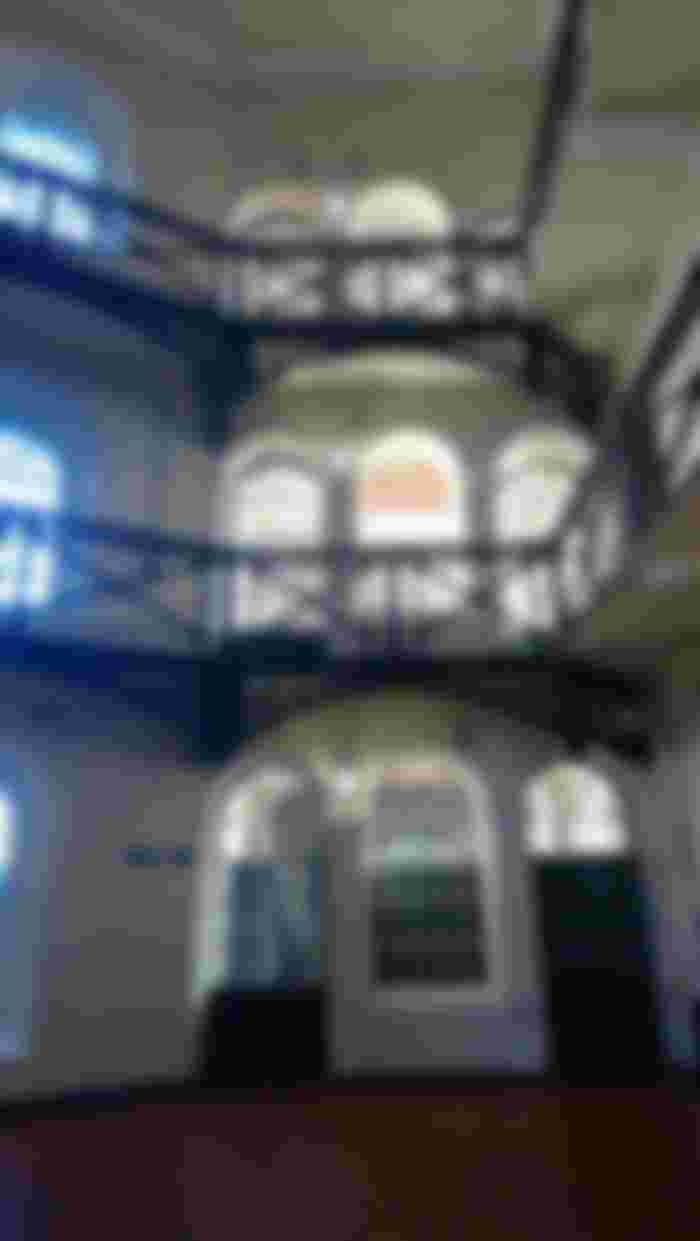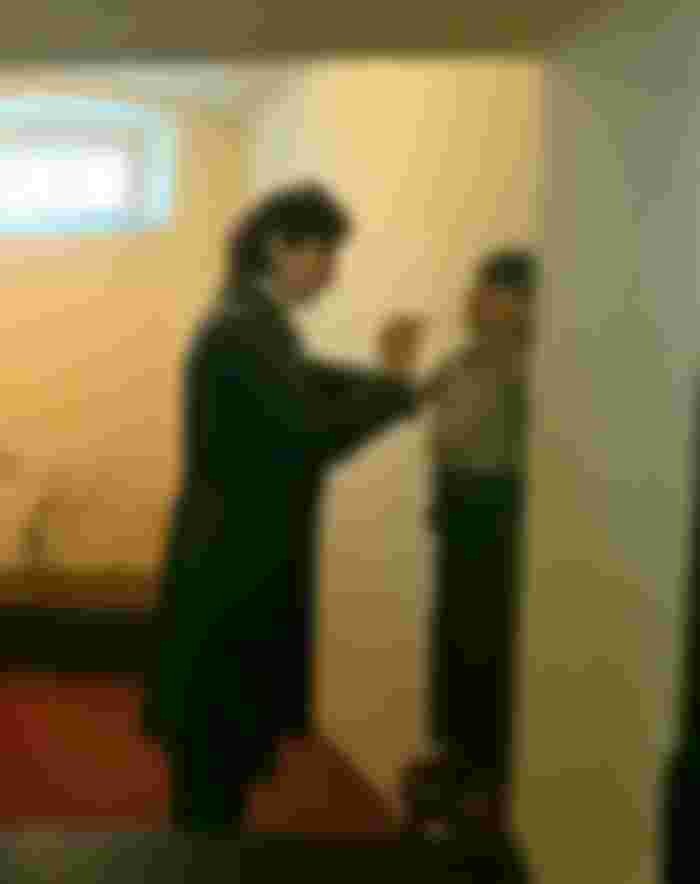The Crumlin Road Gaol is a famous historical jail in Belfast, Northern Ireland. This is a 19th century Grade A jail which opens to the public for guided tours, concerts and different events. This is one of Northern Ireland's 5-star attraction. What makes this Gaol famous? Come and let's find out!
The Crum
Crumlin Road Gaol opened its gates for the very first time to prisoners in 1846. For 150 years, the Crum was a fully operational prison. On March 31, 1996, they closed its doors as a prison and it was empty for many years.
During those 150 years, The Crum has housed over 25 000 prisoners (murderers, loyalist, suffragettes and republican prisoners). It has been the home to executions, escapes and riots.
This is the entrance to the Crumlin Road Gaol.

Just in front of the Gaol is the Courthouse. This is where prisoners get their sentence and they walk through the tunnel house that is connected to the Gaol.
The Courthouse

The Reception Area is on the right side upon entering. And on the left, there's a Gift Shop.

At the reception, if you book your visit online, you just need to give your booking reference. I advise you to book online for discount and faster transaction. The staff will give you a wrist tag as a pass and then will instruct you to go to the assembly point to wait for your tour guide.
You can book online here.
Opening Times
They are open from Monday to Sunday from 10.00 am to 4.30 pm. Check the website for Coronavirus restriction updates.
Ticket Prices
Adult - £12.00 / *£10.80
Child (5-15 yrs) - £7.50 / *£5.00
Concession - £10.00 / *£9.00
Family (2 adults+ 2 children) - £30.00 / *£27.00
Get inside and these are what you are going to see.




This is a guided tour so we go straight to the assembly point to wait for our tour guide.

And while waiting at the assembly area, there are loads of interesting stuff that you can look into.

















Albert Pierrepoint

This is the life mask of executioner Albert Pierrepoint. It was donated by the curator of Wandsworth Prison Museum in London named Stewart McLaughlin. Pierrepoint was the acted assistant at the executions of Harold Courtney in 1933, and Thomas Williams in 1942 that both took place here in Crumlin Gaol.
Matron's Gallery

This is the Matrons Gallery with the Holding Cell on it. Holding Cells is the one used to hold prisoners who were either going to court or awaiting a visit from a legal representative.

Our tour guide named Hannah came and we are 5 on this tour. She started with the history of the Gaol.
History
Sir Charles Lanyon is a famous English civil engineer and architect, designed this Crumlin Road Gaol. (I hope you remember Sir Charles Lanyon from my other article like the one who won the design competition and designed the Scrabo Tower). They began in 1843 and completed in 1845. It became the new House of Correction. It replaced Carrickfergus Gaol as the new Antrim County Gaol in 1846. The Crum is a five-sided walled lot wherein four wings were constructed from black basalt. It was based on Pentonville Prison and it was designed on the Radial Cellular System. It was the first Jail here in Ireland designed for the "Separate System of Solitary Confinement", whereby prisoners were separated from each other and were not allowed to talk.
The first prisoners in The Crum came from Carrickfergus Gaol in 1846. It is said that 106 men, women and children marched on their foot in chains. In the early years, children were imprisoned for petty crimes like stealing food or clothing. The sentences for children ranged from a week to a month and could be increased up to three months (If it's not first time offence) and could include whipping. The youngest child ever recorded was the case of a 10-year-old Patrick Maggie who was charged for stealing clothes from a washerwoman for the second time in April 1858, resulting in months sentence. He hanged himself in his cell on the 27th of April 1858. A new law was passed after the incident and it forbid children under the age of 14 to be sent to an adult prison. After its long years of history the Crum housing murderers, suffragettes, loyalist and republicans ended its 150-year history of imprisonment and executions on March 31, 1996, by the last and final Governor Bill McLoughlin.
The Gaol's layout

Let's head first to the Reception Area.
Reception Area

After receiving their sentence from the Courthouse, the prisoner will walk through the tunnel that is connected to the Gaol straight to the reception area. First, they will log in their details. Then, they will be placed in one of the old cubicles, they will be ordered to strip off their clothes and were photographed, bathed and marched to the basement area of D Wing overnight. Hannah (our tour guide), told us that they were washed to make sure that their tattoos were real. Many ex-prisoners didn't like their experience of this old Victorian reception and described it as being cold and oppressive.
This is what it looks inside. It felt so creepy being there.


You can see the bag hanging in there.
And also some carvings with their names and group on it which gave us the idea that they have some sharp items with them to create such.


Now off to the Governor's Office. This is the only room that has a carpet on it. John Forbes was the first appointed Governor.
Governor's Office

The Photograph of Prison Staff is taken in the early 1900s.

The Tunnel



This is the tunnel that connects the gaol and the courthouse. An estimated 25,000 prisoners had walked through this tunnel between the early 1970s and when the gaol closed in 31st of March 1996.
After that let's go back inside the Gaol and off to the cells. There are four wings A, B, C and D.





PRISON ROUTINE
6 am - Rise
6am-7.30am - Wash & Clean cell
8 am - Breakfast
8.30am-9am - Chapel
9am-12.30pm - Work
12.30pm - Dinner
1pm-6pm - Prison Work
6pm - Supper
7pm-9pm -Instruction
9pm- Lock-up
Let's go straight to the C Wing, these are what you are going to see:
Principal Officer's Office

The Principal Officer (P.O) was the one responsible for the day to day running of the wing. He had approximately 10-20 prison officers under his command: numbers may vary from wing to wing. He was subject to the Chief Officer/Wing Governor.
The Holding and Parcel Cell


1846 Gaol Cell

Each cell is 13 feet long by 7 feet wide and 9 feet 10 inches high and originally had water closet and fixed basin in it.
The Padded Cell

This Padded Cell was used to house prisoners at risk of harming themselves or other inmates and staff. This cell which is constructed in 1934 was originally housed in the B Wing.
The Punishment Cell

"The Boards" was the name given to the punishment cell because of the rough wooden pallet used as a bed. During the day all bedding was removed. It left the prisoner with only a bible, water container, a mug and chamber pot.
Child Prisoners - 1870

While the new law was introduced in 1861 which prevents prisoners under the age of 14 serving their full sentence in an adult prison, it was not unusual for children to be sent here(adult prison) for a short time to "scare them straight". At times, the experience was too much for younger prisoners to bear and in 1871 a 14-year-old boy took his own life in his cell. That's terrible.
1970/80's Cell

The start of the "The Troubles" in 1969 and the introduction of internment without trial in August 1971, brought a sudden and dramatic increase in the prison population which was to last for many years.
Each cell was originally designed for single occupancy. There's an inspection report (1849) recorded a capacity in this gaol for 320. However, during the 1970'/80's the prison population would reach nearly 1,400 which was not uncommon to find 3 prisoners to a single cell. During that time, prisoners were taken from their cell for meals in dining halls adjoining the wings. There was still no sanitation in those cells and chamber pots were used.
The Wing Kitchen

The gaols main kitchens is the one responsible for cooking and preparing the prisoners meals before delivering them to the wings in metal containers called "Dixies". Their food was kept warm on hot plates until serving. That's nice!
Toilets

The Flogging Rack / Corporal Punishment

Rules for Corporal Punishment (1922-1968)
-(88) All corporal punishments shall be attended by the Governor and the Medical Officer (Doctor). The Doctor shall give such orders for preventing injury to health as he may seem necessary.
-(89) In the case of a prisoner over 18 years of age, Corporal Punishment shall be inflicted with a cat o' nine tails or a birch rod and in the case of a prisoner under the age of 18 years with a birch rod.
-(90) The number of lashes or strokes inflicted on a prisoner over 18 years of age shall not exceed 36 while on a prisoner under 18 years of age, 18 lashes.
Political Prisoners
During the 19th century, the Gaol imprisoned political prisoners, the Republicans and Loyalists and it's political conflicts leads the closing of the Crumlin Road Gaol in 31st of March 1996. The most famous political prisoner held in here was the President of the Irish Republic, Eamon de Valera during the troubles of 1919-22. De Valera was imprisoned for a month in 1924 for breaching an order excluding him from Northern Ireland and was imprisoned for a second time in 1929. Also, the Suffragettes were imprisoned in A Wing at the Gaol during the agitation for votes for women before World War 1. These women were incarcerated in the Crumlin Road Gaol. Some of them embarked on a hunger and thirst strike in support of the right to vote.

ESCAPE ATTEMPTS
There's a total of 52 prisoners escaped from the Gaol. Including a successful episode in 1971, when throughout just a single 6 month period, thirteen prisoners were escaped. It was recorded that the last successful escaped took place on 10th of June 1981. There were 8 Republicans escaped from the holding hostage prison officers, solicitors and other prisoners using guns they had smuggled inside the Gaol. They had left through the front gates.
The Condemned Man's Cell

This is a very sad place. Over the lifetime of the Gaol, 17 men were executed in here and their bodies buried within the walls of the prison. And it was part of their sentence to be buried in an unmarked grave, in consecrated ground.

Of the bodies buried here, 15 of them just remain; two were exhumed in 1999 and 2001. On the boundary wall, some of the men's initials can still be seen etched into the stone (Can you see it?), the only visible record of their final resting places.


Before the day of the execution, the condemned man can eat any food he likes, can accept visitors, play cards and smoke with the officers inside the cell. They keep him happy before the execution guess, the least they can do. Two officers were guarding him to make sure he doesn't t take his own life before his execution day. And listen, he didn't know that the execution room is just a door beside his cell, the Drop Room. 😢


You can see in there the 17 names executed in this room. In 1961 was the last time a man was hanged at the Crumlin Road Gaol, but there are two men sentenced to be executed as late as 1973. Their sentences were eventually reduced to jail terms.
I can imagine the condemned man with his head covered in that room. And the feeling that they thought that the execution was cancelled because they are not dragging him outside the door and little did he know that the execution will happen just beside his room. I had to stop imagining.
Watch this video:
Our last stop was the Gift Shop.







And this is me lol

And I want to end this experience with this quote,
"When you are in jail, a good friend will be trying to bail you out. A best friend will be in the cell next to you saying, 'Damn, that was fun'."
-Groucho Marx
I wrote this article with the information I gathered at the tour, Crumlin road gaol site and from this beautiful amazing guide, Hannah.

Thank you so much!

Check out my Travel Articles
Tyn-Y-Mur Caravan and Camping Site in Abersoch, Wales
Abersoch, Wales and the Mishap
La Paz Sand Dunes Adventure in Laoag
My Unforgettable Trip in Morocco
Baluarte Zoo and Safari Gallery in Vigan
Jeep Safari Adventure in Turkey- Part 2
Jeep Safari Adventure in Fethiye(Water Fighting and more) -Part 1
My First Scuba Diving Experience in Fethiye
Staying at the Garcia Resort and Spa in Oludeniz, Turkey
12 Island Boat Trip in Fethiye
Airport Transfer Service in Turkey that You Can Book Online
The Best Turkish Bath Experience in Hisaronu

Remember to SUBSCRIBE if you liked my content! Hit LIKE and COMMENT for more! ❤️❤️❤️
And to my lovely sponsors thank you so much!

P.S.
I created a travel community named "Travel Around the World" if you have any travel post please feel free to use this community so we can all share our travel experiences. Thank you!








































































It became like a museum of sorts? What ever happened tp the prisoners in there by the time the prison was closing? And how many hours did you tour that place?